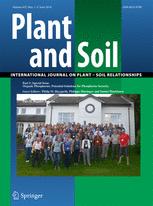Ver ítem
- xmlui.general.dspace_homeCentros Regionales y EEAsCentro Regional Buenos Aires SurEEA Cuenca del SaladoArtículos científicosxmlui.ArtifactBrowser.ItemViewer.trail
- Inicio
- Centros Regionales y EEAs
- Centro Regional Buenos Aires Sur
- EEA Cuenca del Salado
- Artículos científicos
- Ver ítem
Growth, nutrient uptake and symbiosis with rhizobia and arbuscular mycorrhizal fungi in Lotus tenuis plants fertilized with different phosphate sources and inoculated with the phosphate-solubilizing bacterium Pantoea eucalypti M91
Resumen
Background and aims: The aim of this work was to evaluate the ability of P fertilization and phosphate-solubilizing bacteria (PSB) inoculation to promote the growth of L. tenuis in typical soils of the Salado River Basin (Argentina) with low P availability.
Methods: Aboveground biomass and P and N levels were evaluated in field-grown L. tenuis plants inoculated with Pantoea eucalypti M91, either without fertilization or in combination with phosphate rock
[ver mas...]
Background and aims: The aim of this work was to evaluate the ability of P fertilization and phosphate-solubilizing bacteria (PSB) inoculation to promote the growth of L. tenuis in typical soils of the Salado River Basin (Argentina) with low P availability.
Methods: Aboveground biomass and P and N levels were evaluated in field-grown L. tenuis plants inoculated with Pantoea eucalypti M91, either without fertilization or in combination with phosphate rock and triple superphosphate (TSP). The impact of P fertilization and inoculation on the symbiotic interactions between L. tenuis and native rhizobia bacteria and arbuscular mycorrhizal fungi was also evaluated.
Results: Inoculation with M91 increased the L. tenuis biomass production and P concentration in shoots, at an early stage of plant growth. The combined treatment of inoculation with M91 and TSP significantly increased the P and N content in shoots compared to non-inoculated plants, fertilized or not. P. eucalypti M91 was found to endophytically colonize roots and leaves of L. tenuis plants grown in vitro and also under field conditions.
Conclusions: The results suggesting that inoculation of L. tenuis with the PSB such as P. eucalypti M91 strain might allow more efficient use of N and P and a more sustainable option for grasslands producers from the Salado River Basin, in order to reduce costs and avoid increased levels of P insoluble in soils.
[Cerrar]

Autor
Castagno, Luis Nazareno;
García, Ileana Vanesa;
Sannazzaro, Analía Inés;
Bailleres, Matias Andres;
Ruiz, Oscar Adolfo;
Mendoza, Rodolfo Ernesto;
Estrella, Maria Julia;
Fuente
Plant and soil 385 (1–2) : 357–371. (December 2014)
Fecha
2014-12
ISSN
0032-079X
1573-5036
1573-5036
Formato
pdf
Tipo de documento
artículo
Palabras Claves
Derechos de acceso
Restringido
 Excepto donde se diga explicitamente, este item se publica bajo la siguiente descripción: Creative Commons Attribution-NonCommercial-ShareAlike 2.5 Unported (CC BY-NC-SA 2.5)
Excepto donde se diga explicitamente, este item se publica bajo la siguiente descripción: Creative Commons Attribution-NonCommercial-ShareAlike 2.5 Unported (CC BY-NC-SA 2.5)

